Zidong Du
QiMeng: Fully Automated Hardware and Software Design for Processor Chip
Jun 05, 2025Abstract:Processor chip design technology serves as a key frontier driving breakthroughs in computer science and related fields. With the rapid advancement of information technology, conventional design paradigms face three major challenges: the physical constraints of fabrication technologies, the escalating demands for design resources, and the increasing diversity of ecosystems. Automated processor chip design has emerged as a transformative solution to address these challenges. While recent breakthroughs in Artificial Intelligence (AI), particularly Large Language Models (LLMs) techniques, have opened new possibilities for fully automated processor chip design, substantial challenges remain in establishing domain-specific LLMs for processor chip design. In this paper, we propose QiMeng, a novel system for fully automated hardware and software design of processor chips. QiMeng comprises three hierarchical layers. In the bottom-layer, we construct a domain-specific Large Processor Chip Model (LPCM) that introduces novel designs in architecture, training, and inference, to address key challenges such as knowledge representation gap, data scarcity, correctness assurance, and enormous solution space. In the middle-layer, leveraging the LPCM's knowledge representation and inference capabilities, we develop the Hardware Design Agent and the Software Design Agent to automate the design of hardware and software for processor chips. Currently, several components of QiMeng have been completed and successfully applied in various top-layer applications, demonstrating significant advantages and providing a feasible solution for efficient, fully automated hardware/software design of processor chips. Future research will focus on integrating all components and performing iterative top-down and bottom-up design processes to establish a comprehensive QiMeng system.
CodeV-R1: Reasoning-Enhanced Verilog Generation
May 30, 2025Abstract:Large language models (LLMs) trained via reinforcement learning with verifiable reward (RLVR) have achieved breakthroughs on tasks with explicit, automatable verification, such as software programming and mathematical problems. Extending RLVR to electronic design automation (EDA), especially automatically generating hardware description languages (HDLs) like Verilog from natural-language (NL) specifications, however, poses three key challenges: the lack of automated and accurate verification environments, the scarcity of high-quality NL-code pairs, and the prohibitive computation cost of RLVR. To this end, we introduce CodeV-R1, an RLVR framework for training Verilog generation LLMs. First, we develop a rule-based testbench generator that performs robust equivalence checking against golden references. Second, we propose a round-trip data synthesis method that pairs open-source Verilog snippets with LLM-generated NL descriptions, verifies code-NL-code consistency via the generated testbench, and filters out inequivalent examples to yield a high-quality dataset. Third, we employ a two-stage "distill-then-RL" training pipeline: distillation for the cold start of reasoning abilities, followed by adaptive DAPO, our novel RLVR algorithm that can reduce training cost by adaptively adjusting sampling rate. The resulting model, CodeV-R1-7B, achieves 68.6% and 72.9% pass@1 on VerilogEval v2 and RTLLM v1.1, respectively, surpassing prior state-of-the-art by 12~20%, while matching or even exceeding the performance of 671B DeepSeek-R1. We will release our model, training pipeline, and dataset to facilitate research in EDA and LLM communities.
CodeV: Empowering LLMs for Verilog Generation through Multi-Level Summarization
Jul 16, 2024Abstract:The increasing complexity and high costs associated with modern processor design have led to a surge in demand for processor design automation. Instruction-tuned large language models (LLMs) have demonstrated remarkable performance in automatically generating code for general-purpose programming languages like Python. However, these methods fail on hardware description languages (HDLs) like Verilog due to the scarcity of high-quality instruction tuning data, as even advanced LLMs like GPT-3.5 exhibit limited performance on Verilog generation. Regarding this issue, we observe that (1) Verilog code collected from the real world has higher quality than those generated by LLMs. (2) LLMs like GPT-3.5 excel in summarizing Verilog code rather than generating it. Based on these observations, this paper introduces CodeV, a series of open-source instruction-tuned Verilog generation LLMs. Instead of generating descriptions first and then getting the corresponding code from advanced LLMs, we prompt the LLM with Verilog code and let the LLM generate the corresponding natural language description by multi-level summarization. Experimental results show that CodeV relatively surpasses the previous open-source SOTA by 14.4% (BetterV in VerilogEval) and 11.3% (RTLCoder in RTLLM) respectively, and also relatively outperforms previous commercial SOTA GPT-4 by 22.1% in VerilogEval.
TensorTEE: Unifying Heterogeneous TEE Granularity for Efficient Secure Collaborative Tensor Computing
Jul 12, 2024
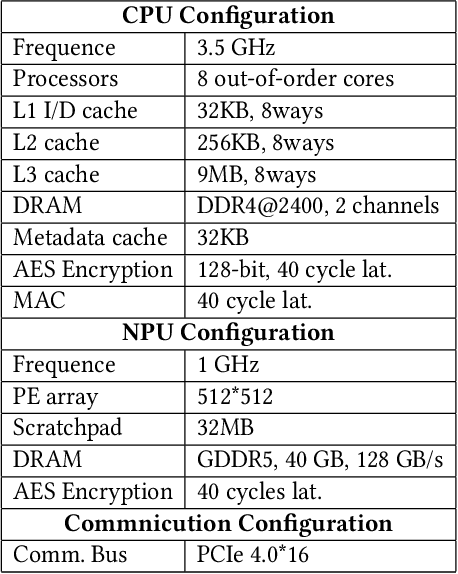
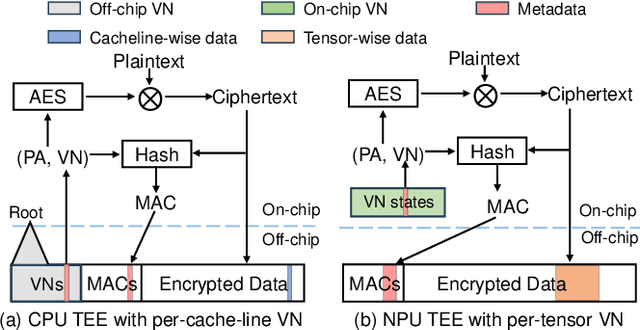
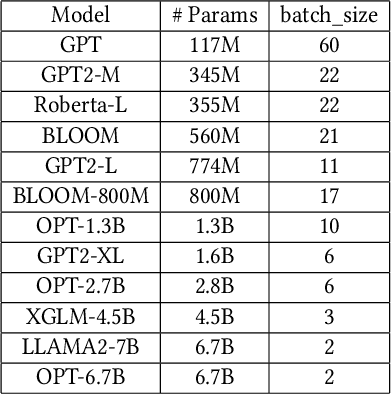
Abstract:Heterogeneous collaborative computing with NPU and CPU has received widespread attention due to its substantial performance benefits. To ensure data confidentiality and integrity during computing, Trusted Execution Environments (TEE) is considered a promising solution because of its comparatively lower overhead. However, existing heterogeneous TEE designs are inefficient for collaborative computing due to fine and different memory granularities between CPU and NPU. 1) The cacheline granularity of CPU TEE intensifies memory pressure due to its extra memory access, and 2) the cacheline granularity MAC of NPU escalates the pressure on the limited memory storage. 3) Data transfer across heterogeneous enclaves relies on the transit of non-secure regions, resulting in cumbersome re-encryption and scheduling. To address these issues, we propose TensorTEE, a unified tensor-granularity heterogeneous TEE for efficient secure collaborative tensor computing. First, we virtually support tensor granularity in CPU TEE to eliminate the off-chip metadata access by detecting and maintaining tensor structures on-chip. Second, we propose tensor-granularity MAC management with predictive execution to avoid computational stalls while eliminating off-chip MAC storage and access. Moreover, based on the unified granularity, we enable direct data transfer without re-encryption and scheduling dilemmas. Our evaluation is built on enhanced Gem5 and a cycle-accurate NPU simulator. The results show that TensorTEE improves the performance of Large Language Model (LLM) training workloads by 4.0x compared to existing work and incurs only 2.1% overhead compared to non-secure training, offering a practical security assurance for LLM training.
InverseCoder: Unleashing the Power of Instruction-Tuned Code LLMs with Inverse-Instruct
Jul 08, 2024Abstract:Recent advancements in open-source code large language models (LLMs) have demonstrated remarkable coding abilities by fine-tuning on the data generated from powerful closed-source LLMs such as GPT-3.5 and GPT-4 for instruction tuning. This paper explores how to further improve an instruction-tuned code LLM by generating data from itself rather than querying closed-source LLMs. Our key observation is the misalignment between the translation of formal and informal languages: translating formal language (i.e., code) to informal language (i.e., natural language) is more straightforward than the reverse. Based on this observation, we propose INVERSE-INSTRUCT, which summarizes instructions from code snippets instead of the reverse. Specifically, given an instruction tuning corpus for code and the resulting instruction-tuned code LLM, we ask the code LLM to generate additional high-quality instructions for the original corpus through code summarization and self-evaluation. Then, we fine-tune the base LLM on the combination of the original corpus and the self-generated one, which yields a stronger instruction-tuned LLM. We present a series of code LLMs named InverseCoder, which surpasses the performance of the original code LLMs on a wide range of benchmarks, including Python text-to-code generation, multilingual coding, and data-science code generation.
Adversarial Contrastive Decoding: Boosting Safety Alignment of Large Language Models via Opposite Prompt Optimization
Jun 24, 2024Abstract:With the widespread application of Large Language Models (LLMs), it has become a significant concern to ensure their safety and prevent harmful responses. While current safe-alignment methods based on instruction fine-tuning and Reinforcement Learning from Human Feedback (RLHF) can effectively reduce harmful responses from LLMs, they often require high-quality datasets and heavy computational overhead during model training. Another way to align language models is to modify the logit of tokens in model outputs without heavy training. Recent studies have shown that contrastive decoding can enhance the performance of language models by reducing the likelihood of confused tokens. However, these methods require the manual selection of contrastive models or instruction templates. To this end, we propose Adversarial Contrastive Decoding (ACD), an optimization-based framework to generate two opposite system prompts for prompt-based contrastive decoding. ACD only needs to apply a lightweight prompt tuning on a rather small anchor dataset (< 3 min for each model) without training the target model. Experiments conducted on extensive models and benchmarks demonstrate that the proposed method achieves much better safety performance than previous model training-free decoding methods without sacrificing its original generation ability.
Prompt-based Visual Alignment for Zero-shot Policy Transfer
Jun 05, 2024



Abstract:Overfitting in RL has become one of the main obstacles to applications in reinforcement learning(RL). Existing methods do not provide explicit semantic constrain for the feature extractor, hindering the agent from learning a unified cross-domain representation and resulting in performance degradation on unseen domains. Besides, abundant data from multiple domains are needed. To address these issues, in this work, we propose prompt-based visual alignment (PVA), a robust framework to mitigate the detrimental domain bias in the image for zero-shot policy transfer. Inspired that Visual-Language Model (VLM) can serve as a bridge to connect both text space and image space, we leverage the semantic information contained in a text sequence as an explicit constraint to train a visual aligner. Thus, the visual aligner can map images from multiple domains to a unified domain and achieve good generalization performance. To better depict semantic information, prompt tuning is applied to learn a sequence of learnable tokens. With explicit constraints of semantic information, PVA can learn unified cross-domain representation under limited access to cross-domain data and achieves great zero-shot generalization ability in unseen domains. We verify PVA on a vision-based autonomous driving task with CARLA simulator. Experiments show that the agent generalizes well on unseen domains under limited access to multi-domain data.
Luban: Building Open-Ended Creative Agents via Autonomous Embodied Verification
May 24, 2024Abstract:Building open agents has always been the ultimate goal in AI research, and creative agents are the more enticing. Existing LLM agents excel at long-horizon tasks with well-defined goals (e.g., `mine diamonds' in Minecraft). However, they encounter difficulties on creative tasks with open goals and abstract criteria due to the inability to bridge the gap between them, thus lacking feedback for self-improvement in solving the task. In this work, we introduce autonomous embodied verification techniques for agents to fill the gap, laying the groundwork for creative tasks. Specifically, we propose the Luban agent target creative building tasks in Minecraft, which equips with two-level autonomous embodied verification inspired by human design practices: (1) visual verification of 3D structural speculates, which comes from agent synthesized CAD modeling programs; (2) pragmatic verification of the creation by generating and verifying environment-relevant functionality programs based on the abstract criteria. Extensive multi-dimensional human studies and Elo ratings show that the Luban completes diverse creative building tasks in our proposed benchmark and outperforms other baselines ($33\%$ to $100\%$) in both visualization and pragmatism. Additional demos on the real-world robotic arm show the creation potential of the Luban in the physical world.
Assessing and Understanding Creativity in Large Language Models
Jan 23, 2024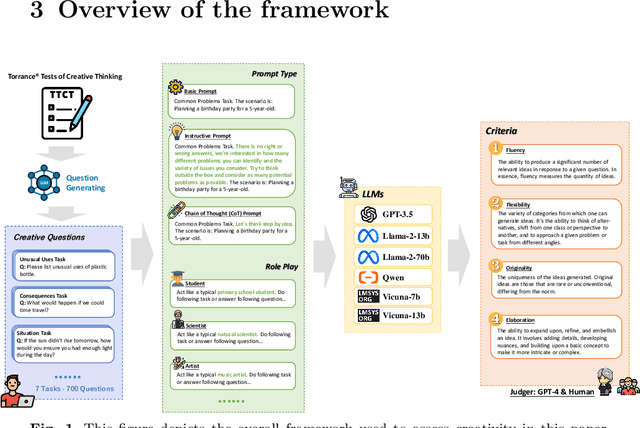
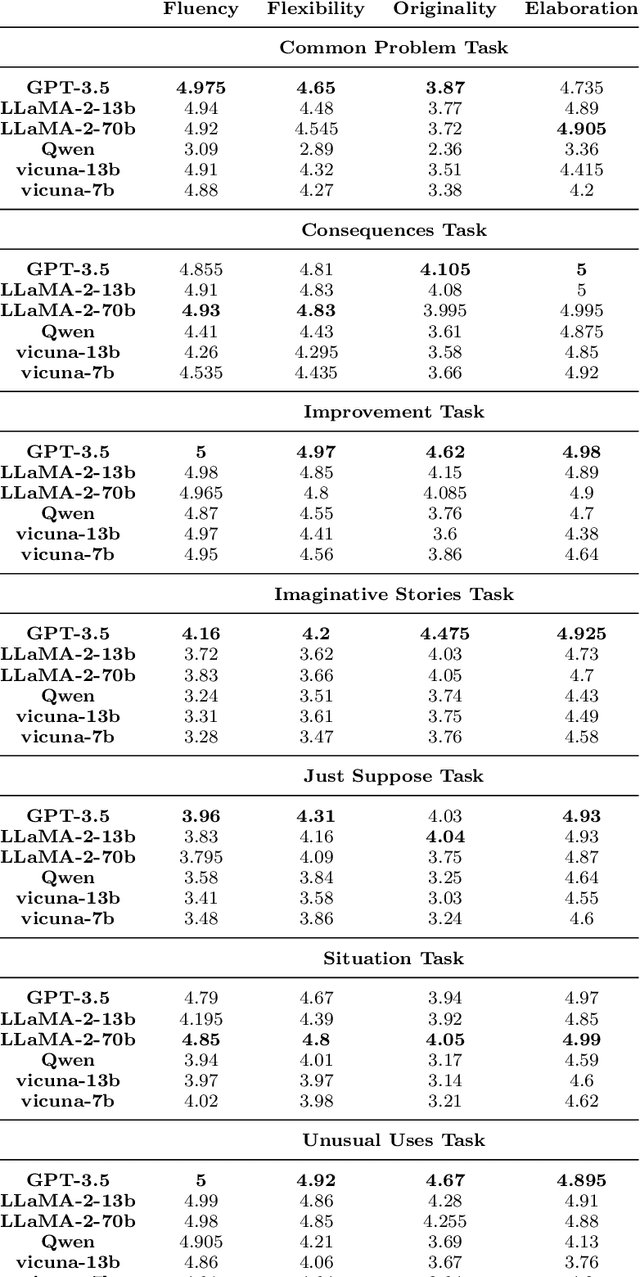
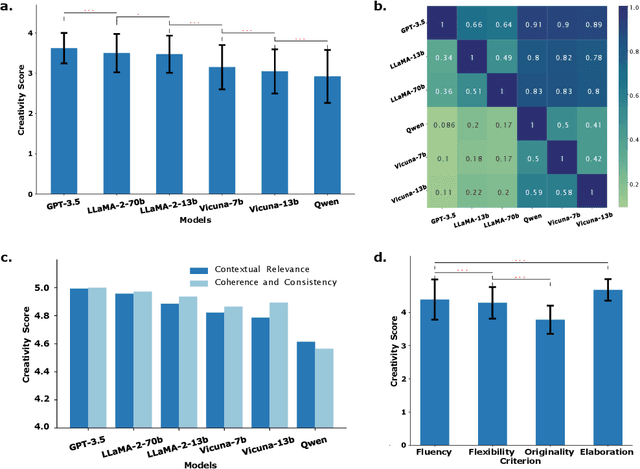
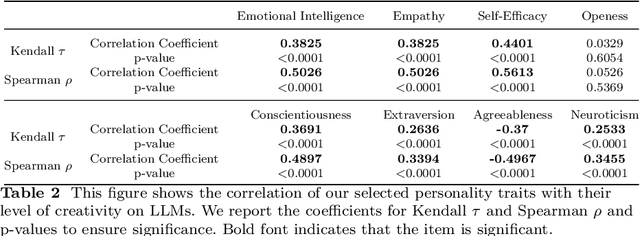
Abstract:In the field of natural language processing, the rapid development of large language model (LLM) has attracted more and more attention. LLMs have shown a high level of creativity in various tasks, but the methods for assessing such creativity are inadequate. The assessment of LLM creativity needs to consider differences from humans, requiring multi-dimensional measurement while balancing accuracy and efficiency. This paper aims to establish an efficient framework for assessing the level of creativity in LLMs. By adapting the modified Torrance Tests of Creative Thinking, the research evaluates the creative performance of various LLMs across 7 tasks, emphasizing 4 criteria including Fluency, Flexibility, Originality, and Elaboration. In this context, we develop a comprehensive dataset of 700 questions for testing and an LLM-based evaluation method. In addition, this study presents a novel analysis of LLMs' responses to diverse prompts and role-play situations. We found that the creativity of LLMs primarily falls short in originality, while excelling in elaboration. Besides, the use of prompts and the role-play settings of the model significantly influence creativity. Additionally, the experimental results also indicate that collaboration among multiple LLMs can enhance originality. Notably, our findings reveal a consensus between human evaluations and LLMs regarding the personality traits that influence creativity. The findings underscore the significant impact of LLM design on creativity and bridges artificial intelligence and human creativity, offering insights into LLMs' creativity and potential applications.
Emergent Communication for Rules Reasoning
Nov 08, 2023



Abstract:Research on emergent communication between deep-learning-based agents has received extensive attention due to its inspiration for linguistics and artificial intelligence. However, previous attempts have hovered around emerging communication under perception-oriented environmental settings, that forces agents to describe low-level perceptual features intra image or symbol contexts. In this work, inspired by the classic human reasoning test (namely Raven's Progressive Matrix), we propose the Reasoning Game, a cognition-oriented environment that encourages agents to reason and communicate high-level rules, rather than perceived low-level contexts. Moreover, we propose 1) an unbiased dataset (namely rule-RAVEN) as a benchmark to avoid overfitting, 2) and a two-stage curriculum agent training method as a baseline for more stable convergence in the Reasoning Game, where contexts and semantics are bilaterally drifting. Experimental results show that, in the Reasoning Game, a semantically stable and compositional language emerges to solve reasoning problems. The emerged language helps agents apply the extracted rules to the generalization of unseen context attributes, and to the transfer between different context attributes or even tasks.
 Add to Chrome
Add to Chrome Add to Firefox
Add to Firefox Add to Edge
Add to Edge